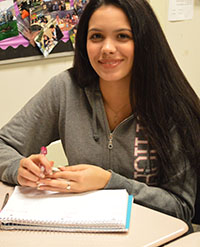High School English language teacher Edith Trumbell spends her days with students from Mexico, China, Congo, Puerto Rico, Cuba, Syria, El Salvador, Honduras, Guatemala and Japan.
For her, teaching them is a privilege. She talks about it with tears glinting in her eyes. “It’s really great to form a community of students from all over the world, within the school community,” she said.
Peek in her classroom and it’s just that. Students with different backgrounds, cultures and native tongues create a community with Trumbell at the helm. Many students start in her Newcomers class speaking little or no English. She sees them progress step by step, word by word, eventually exiting the language program and even moving on to honors class and graduation. “I’m so proud of them,” she said.
Related Story: High Expectations for EL Students – Letter by letter, fourth-grader David Espinoza read through the alphabet on flash cards. English-learner teacher Nicole Adams timed him with a stopwatch at 40 seconds. Unsatisfied, David wanted to try again. “Last week you were only able to do it in one minute. Now 40 seconds seems slow,” Adams said.
Trumbell has taught at Wyoming High School since 2002, and she loves to see students learn to communicate academically as well as to express what’s in their hearts. The class spends time weekly sharing good news, writing down things that have gone well or made them happy.
There is a shortage of teachers like Trumbell in Michigan. Aquinas College is working to address the dearth of English as a Second Language teachers, as an increasing number of students with many different native tongues are in need of instruction.

The college received a five-year, $2.5 million grant from the U.S. Department of Education to help address the shortage of ESL and bilingual teachers in Michigan. The college will receive the grant funding in increments of $425,000 to $549,000 per year for five years. The grant program is in partnership with eight schools systems: Grand Rapids, Kentwood, Wyoming, Kelloggsville, Godfrey-Lee and Godwin Heights, Kent ISD and the Diocese of Grand Rapids Office of Catholic Schools.
The grant will provide opportunities to have more local teachers either endorsed in ESL or bilingual endorsement. It pays for participating teachers’ tuitions and fees, and will also allow Aquinas to use feedback from teachers and school districts to improve and expand its own ESL and bilingual program.
“Through the endorsement process, teachers who were not trained in teaching ESLs/Bilingual students will establish a solid foundation and expand their knowledge base to teach these students effectively,” said Rui Nui-Cooper, associate professor of education at Aquinas College. “More important, the participating teachers will gain the qualifications they needed to teach or work with these students.”
In the past three years, there has been a more than 9 percent ESL population increase, according to EDFacts, a DOE initiative. Kent County school enrollment data show that ESLs are from 30-75 different language backgrounds.
There currently are 88,000 EL students in Michigan, but the total number of ESL/Bilingual programs numbers about 300, and active, endorsed ESL/Bilingual teachers in 2014-2015 numbered only 583, according to 2016 data from the Michigan Department of Education. This provides a teacher-student ratio of 1 to 151.
“Because of fiscal constraints, school districts and individual teachers have been unable to acquire additional training that would benefit students who are not only working to learn regular curriculum content but an entirely new language as well,” Nui-Cooper said.

Local Districts Feel The Shortage
The shortage is evident at Godwin Heights Public Schools, where the ESL student population has increased as immigrant populations move in. The district also lost ESL teachers due to a retirement incentive two years ago. A large percentage of students are Hispanic, and more than a dozen other languages are spoken district-wide, said Michelle Krynicki, the district’s director of instruction.
“We’re very excited about the possibility to work with Aquinas,” Krynicki said. “Giving kids the opportunity to comprehend things and access content at different levels opens up a whole new world for them.”
At Grand Rapids Public Schools, about 4,000 students, or 25 percent of the district’s student population, is ESL. While most are Spanish speaking, other languages include Somali, Arabic and Kinyarwanda. More refugee students from African countries are expected to arrive in the next few months.
“We have a shortage of teachers that are ESL certified,” said Mayda Bahamonde-Gunnell, GRPS executive director for leadership Middle School, English Language Learner and Equity and Inclusion programs. “The grant will help build the capacity in our district for the future.”
Bahamonde-Gunnell said the goal is for GRPS to increase the number of general-ed teachers with ESL endorsements. That way, teachers can use ESL strategies while teaching, math, language arts, science and social studies.
Aquinas College student Ashley Greenup, a student teacher in Trumbell’s Wyoming High School class, said she’s interested in opportunities the grant might allow her. She said she believes part of the reason for the shortage is that people believe bilingualism is a requirement to teach ESL, but it’s not. Also the idea of teaching students who speak many different languages can be intimidating.
“It’s also the best thing ever,” she said, describing how fulfilling it is to see a student progress. “That makes any intimidations worth it… They want to learn so much and they appreciate what you teach them so much.”
CONNECT
Aquinas College









